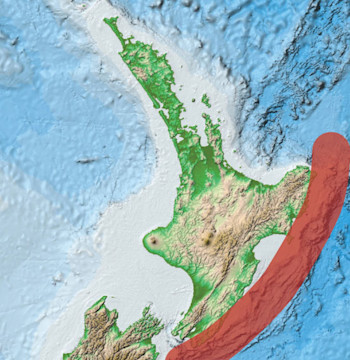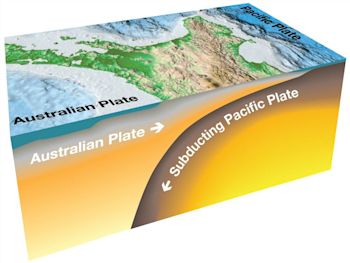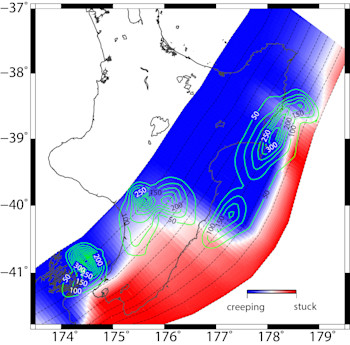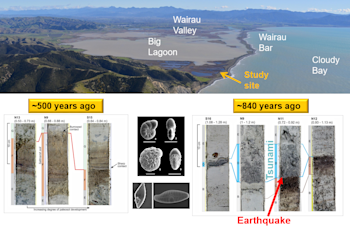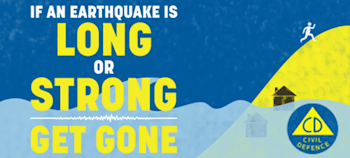
Some facts about the Hikurangi subduction zone - New Zealand’s largest plate boundary fault
Updated: Mon Oct 7 2024 1:50 PM
There has been a lot of attention on the Hikurangi subduction zone – we want people to be aware of the fault and know its potential for future earthquakes and tsunamis
Read the latest on the Hikurangi Subduction Zone in our 2024 series:
The Hikurangi subduction zone (sometimes referred to as the Hikurangi subduction margin) is New Zealand’s largest fault - it is a plate boundary fault (where two plates meet). In this case, it is where the Pacific Plate dives (or "subducts") beneath the Australian Plate.
What is happening along the Hikurangi subduction zone?
The image below shows the general location of the offshore part of the plate boundary. The Hikurangi subduction zone starts in the northeastern South Island and extends up past East Cape. The Pacific Plate dives westward beneath the North Island, starting at the offshore Hikurangi Trough. It lies about 25 km beneath Wellington and about 15 km beneath Napier and Gisborne.
The subduction zone offshore Gisborne accommodates ~6 cm/yr of plate movement while offshore the Wairarapa this decreases to 2-3 cm/yr.
GPS measurements in the North Island suggest that parts of the plate boundary beneath the lower North Island are locked and building up stress that will eventually be released as earthquakes. Earthquakes that occur at the boundary between two plates at a subduction zone are referred to as subduction earthquakes, or sometimes as "megathrust earthquakes".
Because much of the plate boundary is beneath the ocean, when an earthquake occurs it may suddenly displace the seafloor and all the ocean overlying it and consequently generate a tsunami.
At the Hikurangi margin, we also know that some of the built-up stress is released as slow slip events or "slow slip earthquakes" where the stress is released over weeks to months. The Global Positioning System (GPS) sites in the GeoNet network show us when and where slow slip events are occurring on the Hikurangi subduction zone.
Offshore of the Gisborne and Hawkes Bay regions, GPS stations have recorded many slow slip events since they were first discovered in 2002 (see here and here). Slow slip events have also been recorded roughly every five years beneath the Kapiti Coast and Manawatu regions. Slow slip events were also triggered by the Kaikoura M7.8 earthquake in most of these locations (except for Manawatu).
Most of the northern part of the Hikurangi subduction zone appears to be either creeping steadily, or moving in slow slip events. In contrast, the southern part of the fault boundary beneath the lower North Island appears to be locked due to friction on the fault. This locking causes a build-up of stress that may be relieved in a future earthquake. The locking of two plates is also called "coupling".
The red area in the image below show where the fault boundary is locked (where plate coupling is occurring). The blue area shows the plates are creeping past each other, and the green contours show areas of past slow slip events.
What does this tell us about the potential for earthquakes?
If we look back in prehistory and use geological evidence of what has happened in the past (paleoseismology) it helps us understand what is possible in the future.
Unfortunately, we do not have a clear record of past earthquakes along this fault boundary. This is because the plate boundary is mostly located offshore or deep beneath the land, and there are very few places that can preserve clear evidence of past large earthquakes. In some places along the coastline though, we have found geological evidence of where and when the ground level has suddenly either lifted up or dropped down (subsided) – this is a classic signal of a past large subduction earthquake.
For example, our scientists have used sediment cores, such as from Big Lagoon near Blenheim, to interpret past subduction earthquakes. Sediment cores of the salt marsh showed us that there was a sudden land level drop twice in the past 1000 years, one of these sudden drops occurred immediately before a large tsunami.
This tells us that large subduction earthquakes (probably M8 and above) have occurred in the past and it is likely that large earthquakes on the Hikurangi subduction zone will happen again in the future. Our record of the past earthquakes is not yet long enough or detailed enough to allow us to say when and where an earthquake will occur in the future.
A better earthquake record for the Hikurangi subduction zone is a work in progress and our scientists have been collecting core samples along the east coast of the North Island to try and build a better picture of the past to help us understand what might happen in the future. For example, earthquake geologists have built up a very long record of past earthquakes for the Alpine Fault going back 8,000 years. This helps us to know how often to expect earthquakes on the Alpine Fault. We are in the process of trying to build a similarly long and detailed record for the Hikurangi subduction zone so that we can understand how often the Hikurangi subduction zone ruptures in earthquakes, and how large those earthquakes might be.
The work we have done so far suggests that the Hikurangi subduction zone can produce earthquakes of magnitude 8 or greater. It is possible that it could rupture in a magnitude 9 earthquake event (similar to those in Japan in 2011 and Sumatra in 2004), but we still don’t have clear evidence of this yet. If magnitude 9 earthquakes do occur at the Hikurangi subduction zone, they are likely to be relatively rare.
What can I do?
We know that when there is a lot of information out there it can be overwhelming, and hard to know what to do. So, it’s important to know that a large megathrust earthquake and tsunami is possible but it’s also important to know what to do.
Remember: Long or strong, get gone.
Our earthquake and tsunami safety campaign extends to TV from Friday 23 December. Find out more at www.civildefence.govt.nz
The key message is that there are preparedness measures we can take. If you want to know about tsunami evacuation zone maps your regional Civil Defence Emergency Management Group has advice and links to your local maps. Make a plan.
Science input from Dr Laura Wallace and Dr Kate Clark, from GNS Science
